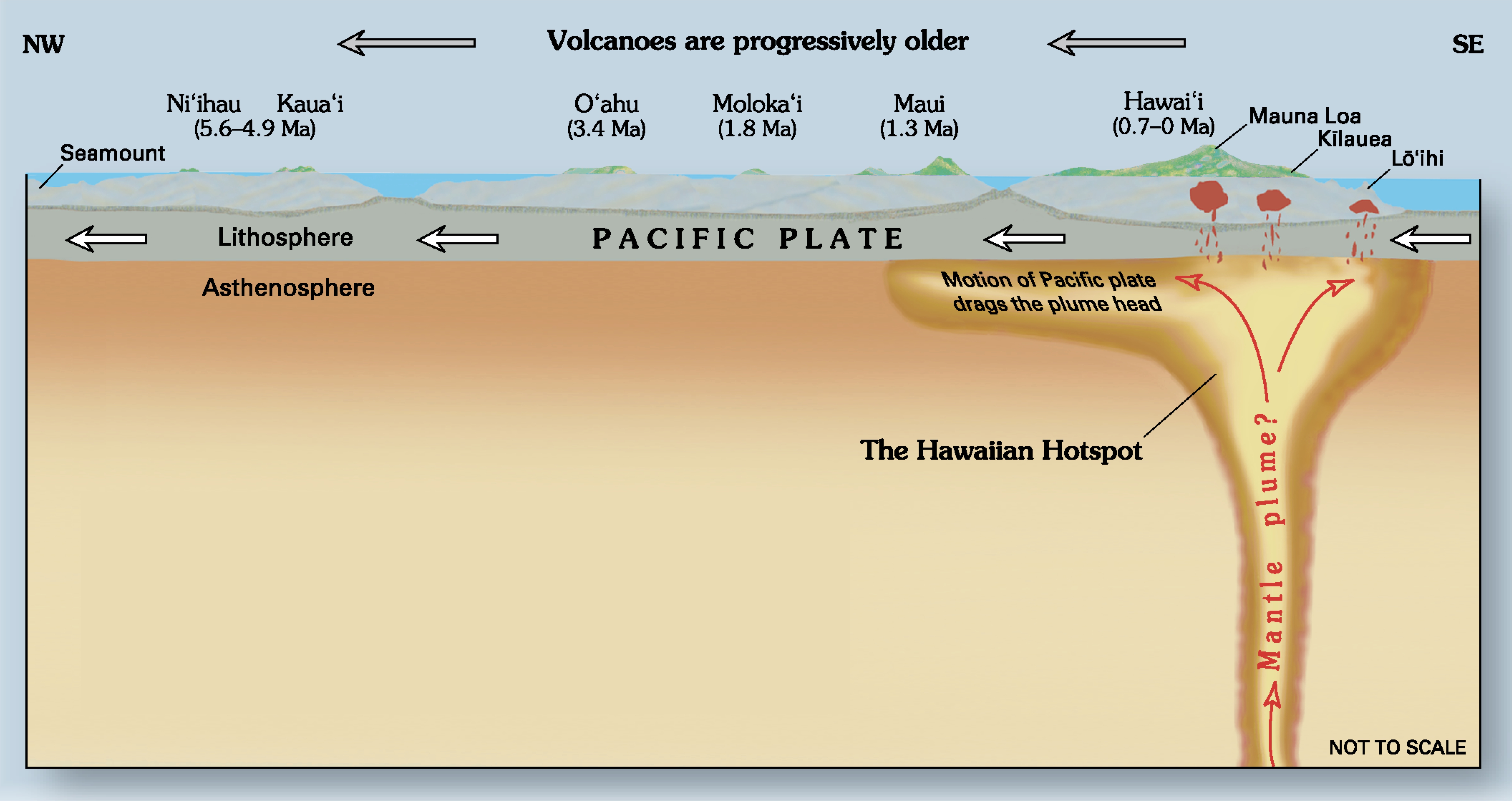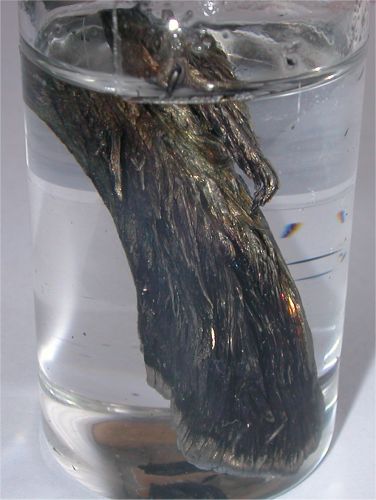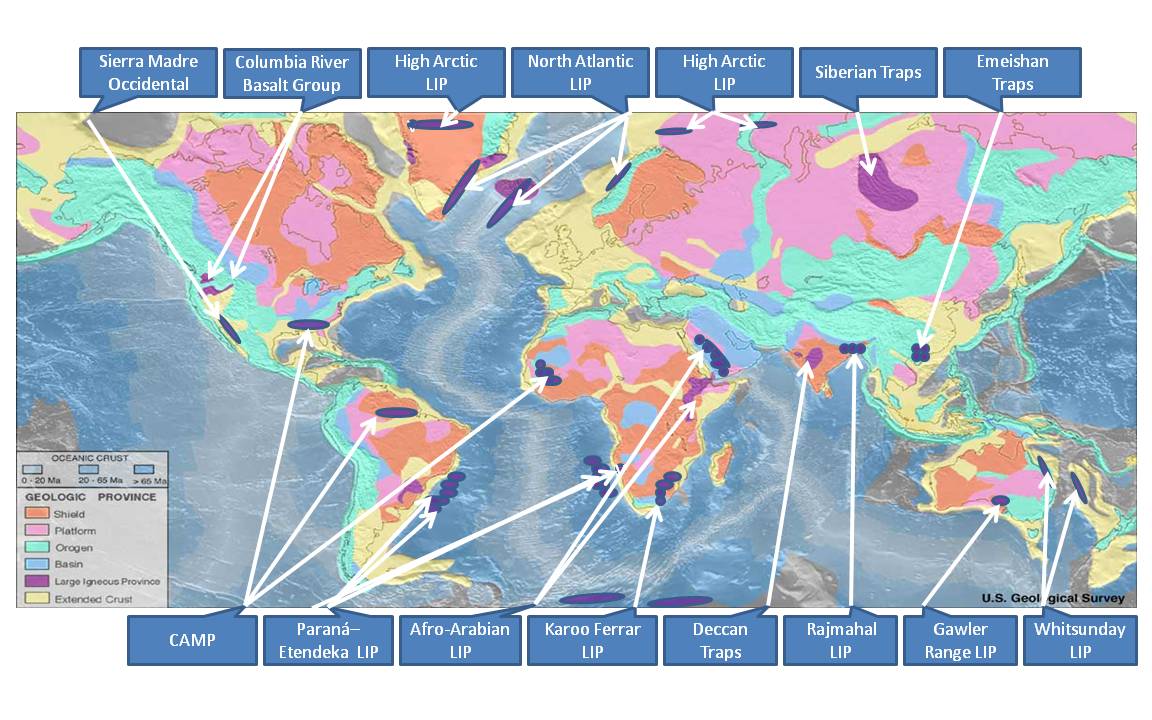|
Ocean Island Basalt
Ocean island basalt (OIB) is a volcanic rock, usually basaltic in composition, erupted in oceans away from tectonic plate boundaries. Although ocean island basaltic magma is mainly erupted as basalt lava, the basaltic magma is sometimes modified by igneous differentiation to produce a range of other volcanic rock types, for example, rhyolite in Iceland, and phonolite and trachyte at the intraplate volcano Fernando de Noronha. Unlike mid-ocean ridge basalts (MORBs), which erupt at spreading centers ( divergent plate boundaries), and volcanic arc lavas, which erupt at subduction zones ( convergent plate boundaries), ocean island basalts are the result of intraplate volcanism. However, some ocean island basalt locations coincide with plate boundaries like Iceland, which sits on top of a mid-ocean ridge, and Samoa, which is located near a subduction zone. In the ocean basins, ocean island basalts form seamounts, and in some cases, enough material is erupted that the rock protrudes fro ... [...More Info...] [...Related Items...] OR: [Wikipedia] [Google] [Baidu] |
Hawaii Hotspot Cross-sectional Diagram
Hawaii ( ; ) is an island U.S. state, state of the United States, in the Pacific Ocean about southwest of the U.S. mainland. One of the two Non-contiguous United States, non-contiguous U.S. states (along with Alaska), it is the only state not on the North American mainland, the only state that is an archipelago, and the only state in the tropics. Hawaii consists of 137 volcanic islands that comprise almost the entire Hawaiian Islands, Hawaiian archipelago (the exception, which is outside the state, is Midway Atoll). Spanning , the state is Physical geography, physiographically and Ethnology, ethnologically part of the Polynesian subregion of Oceania. Hawaii's ocean coastline is consequently the List of U.S. states and territories by coastline, fourth-longest in the U.S., at about . The eight main islands, from northwest to southeast, are Niihau, Niihau, Kauai, Kauai, Oahu, Oahu, Molokai, Molokai, Lanai, Lānai, Kahoʻolawe, Kahoolawe, Maui, and Hawaii (island), Hawaii, a ... [...More Info...] [...Related Items...] OR: [Wikipedia] [Google] [Baidu] |
Convergent Plate Boundaries
A convergent boundary (also known as a destructive boundary) is an area on Earth where two or more lithospheric plates collide. One plate eventually slides beneath the other, a process known as subduction. The subduction zone can be defined by a plane where many earthquakes occur, called the Wadati–Benioff zone. These collisions happen on scales of millions to tens of millions of years and can lead to volcanism, earthquakes, orogenesis, destruction of lithosphere, and deformation. Convergent boundaries occur between oceanic-oceanic lithosphere, oceanic-continental lithosphere, and continental-continental lithosphere. The geologic features related to convergent boundaries vary depending on crust types. Plate tectonics is driven by convection cells in the mantle. Convection cells are the result of heat generated by the radioactive decay of elements in the mantle escaping to the surface and the return of cool materials from the surface to the mantle. These convection cells bring ... [...More Info...] [...Related Items...] OR: [Wikipedia] [Google] [Baidu] |
Strontium
Strontium is a chemical element; it has symbol Sr and atomic number 38. An alkaline earth metal, it is a soft silver-white yellowish metallic element that is highly chemically reactive. The metal forms a dark oxide layer when it is exposed to air. Strontium has physical and chemical properties similar to those of its two vertical neighbors in the periodic table, calcium and barium. It occurs naturally mainly in the minerals celestine and strontianite, and is mostly mined from these. Both strontium and strontianite are named after Strontian, a village in Scotland near which the mineral was discovered in 1790 by Adair Crawford and William Cruickshank; it was identified as a new element the next year from its crimson-red flame test color. Strontium was first isolated as a metal in 1808 by Humphry Davy using the then newly discovered process of electrolysis. During the 19th century, strontium was mostly used in the production of sugar from sugar beets (see strontian proces ... [...More Info...] [...Related Items...] OR: [Wikipedia] [Google] [Baidu] |
Radiogenic Isotope
A radiogenic nuclide is a nuclide that is produced by a process of radioactive decay. It may itself be radioactive (a radionuclide) or stable (a stable nuclide). Radiogenic nuclides (more commonly referred to as radiogenic isotopes) form some of the most important tools in geology. They are used in two principal ways: #In comparison with the quantity of the radioactive 'parent isotope' in a system, the quantity of the radiogenic 'daughter product' is used as a radiometric dating tool (e.g. uranium–lead geochronology). #In comparison with the quantity of a non-radiogenic isotope of the same element, the quantity of the radiogenic isotope is used to define its isotopic signature (e.g. 206Pb/204Pb). This technique is discussed in more detail under the heading isotope geochemistry. Examples Some naturally occurring isotopes are entirely radiogenic, but all those are radioactive isotopes, with half-lives too short to have occurred primordially and still exist today. Thus, they ... [...More Info...] [...Related Items...] OR: [Wikipedia] [Google] [Baidu] |
Subduction
Subduction is a geological process in which the oceanic lithosphere and some continental lithosphere is recycled into the Earth's mantle at the convergent boundaries between tectonic plates. Where one tectonic plate converges with a second plate, the heavier plate dives beneath the other and sinks into the mantle. A region where this process occurs is known as a subduction zone, and its surface expression is known as an arc-trench complex. The process of subduction has created most of the Earth's continental crust. Rates of subduction are typically measured in centimeters per year, with rates of convergence as high as 11 cm/year. Subduction is possible because the cold and rigid oceanic lithosphere is slightly denser than the underlying asthenosphere, the hot, ductile layer in the upper mantle. Once initiated, stable subduction is driven mostly by the negative buoyancy of the dense subducting lithosphere. The down-going slab sinks into the mantle largely under its own ... [...More Info...] [...Related Items...] OR: [Wikipedia] [Google] [Baidu] |
Hawaiian–Emperor Seamount Chain
The Hawaiian–Emperor seamount chain is a mostly undersea mountain range in the Pacific Ocean that reaches above sea level in Hawaii. It is composed of the Hawaiian ridge, consisting of the islands of the Hawaiian chain northwest to Kure Atoll, and the Emperor Seamounts: together they form a vast underwater mountain region of islands and intervening seamounts, atolls, shallows, banks and reefs along a line trending southeast to northwest beneath the northern Pacific Ocean. The seamount chain, containing over 80 identified undersea volcanoes, stretches about from the Aleutian Trench off the coast of the Kamchatka peninsula in the far northwest Pacific to the Kamaʻehuakanaloa Seamount (formerly Lōʻihi), the youngest volcano in the chain, which lies about southeast of the Island of Hawaiʻi. Regions The chain can be divided into three subsections. The first, the Hawaiian archipelago (also known as the ''Windward isles''), consists of the islands comprising the U.S. state ... [...More Info...] [...Related Items...] OR: [Wikipedia] [Google] [Baidu] |
Large Igneous Provinces
A large igneous province (LIP) is an extremely large accumulation of igneous rocks, including intrusive ( sills, dikes) and extrusive (lava flows, tephra deposits), arising when magma travels through the crust towards the surface. The formation of LIPs is variously attributed to mantle plumes or to processes associated with divergent plate tectonics. The formation of some of the LIPs in the past 500 million years coincide in time with mass extinctions and rapid climatic changes, which has led to numerous hypotheses about causal relationships. LIPs are fundamentally different from any other currently active volcanoes or volcanic systems. Overview Definition In 1992, Coffin and Eldholm initially defined the term "large igneous province" as representing a variety of mafic igneous provinces with areal extent greater than 100,000 km2 that represented "massive crustal emplacements of predominantly mafic (magnesium- and iron-rich) extrusive and intrusive rock, and origina ... [...More Info...] [...Related Items...] OR: [Wikipedia] [Google] [Baidu] |
Mantle Plume
A mantle plume is a proposed mechanism of convection within the Earth's mantle, hypothesized to explain anomalous volcanism. Because the plume head partially melts on reaching shallow depths, a plume is often invoked as the cause of volcanic hotspots, such as Hawaii or Iceland, and large igneous provinces such as the Deccan and Siberian Traps. Some such volcanic regions lie far from tectonic plate boundaries, while others represent unusually large-volume volcanism near plate boundaries. Concepts Mantle plumes were first proposed by J. Tuzo Wilson in 1963 and further developed by W. Jason Morgan in 1971 and 1972. A mantle plume is posited to exist where super-heated material forms ( nucleates) at the core-mantle boundary and rises through the Earth's mantle. Rather than a continuous stream, plumes should be viewed as a series of hot bubbles of material. Reaching the brittle upper Earth's crust they form diapirs. These diapirs are "hotspots" in the crust. In particular, ... [...More Info...] [...Related Items...] OR: [Wikipedia] [Google] [Baidu] |
Earth's Mantle
Earth's mantle is a layer of silicate mineral, silicate rock between the Earth's crust, crust and the Earth's outer core, outer core. It has a mass of and makes up 67% of the mass of Earth. It has a thickness of making up about 46% of Earth's radius and 84% of Earth's volume. It is predominantly solid but, on geologic time scales, it behaves as a viscosity, viscous fluid, sometimes described as having the consistency of caramel. Partial melting of the mantle at mid-ocean ridges produces oceanic crust, and partial melting of the mantle at subduction zones produces continental crust. Structure Rheology Earth's upper mantle is divided into two major rheology, rheological layers: the rigid lithosphere comprising the uppermost mantle (the lithospheric mantle), and the more ductile asthenosphere, separated by the Lithosphere-Asthenosphere boundary, lithosphere-asthenosphere boundary. Lithosphere underlying ocean crust has a thickness of around , whereas lithosphere underlying cont ... [...More Info...] [...Related Items...] OR: [Wikipedia] [Google] [Baidu] |
Hotspot (geology)
In geology, hotspots (or hot spots) are volcanic locales thought to be fed by underlying Mantle (geology), mantle that is anomalously hot compared with the surrounding mantle. Examples include the Hawaii hotspot, Hawaii, Iceland hotspot, Iceland, and Yellowstone hotspots. A hotspot's position on the Earth's surface is independent of plate boundary, tectonic plate boundaries, and so hotspots may create a chain of volcanoes as the plates move above them. There are two hypotheses that attempt to explain their origins. One suggests that hotspots are due to mantle plumes that rise as thermal diapirs from the core–mantle boundary. The alternative plate theory (volcanism), plate theory is that the mantle source beneath a hotspot is not anomalously hot, rather the crust above is unusually weak or thin, so that lithospheric extension permits the passive rising of melt from shallow depths. Origin The origins of the concept of hotspots lie in the work of J. Tuzo Wilson, who postulated ... [...More Info...] [...Related Items...] OR: [Wikipedia] [Google] [Baidu] |
Guyot
In marine geology, a guyot (), also called a tablemount, is an isolated underwater volcanic mountain (seamount) with a flat top more than below the surface of the sea. The diameters of these flat summits can exceed . Guyots are most commonly found in the Pacific Ocean, but they have been identified in all the oceans except the Arctic Ocean. They are analogous to tables (such as mesas) on land. History Guyots were first recognized in 1945 by Harry Hammond Hess, who collected data using echo-sounding equipment on a ship he commanded during World War II. His data showed that some undersea mountains had flat tops. Hess called these undersea mountains "guyots", after the Department of Geosciences building at Princeton. Hess postulated they were once volcanic islands that were beheaded by wave action, yet they are now deep under sea level. This idea was used to help bolster the theory of plate tectonics. Formation Guyots show evidence of having once been above the surface, with gr ... [...More Info...] [...Related Items...] OR: [Wikipedia] [Google] [Baidu] |
Hawaii
Hawaii ( ; ) is an island U.S. state, state of the United States, in the Pacific Ocean about southwest of the U.S. mainland. One of the two Non-contiguous United States, non-contiguous U.S. states (along with Alaska), it is the only state not on the North American mainland, the only state that is an archipelago, and the only state in the tropics. Hawaii consists of 137 volcanic islands that comprise almost the entire Hawaiian Islands, Hawaiian archipelago (the exception, which is outside the state, is Midway Atoll). Spanning , the state is Physical geography, physiographically and Ethnology, ethnologically part of the Polynesian subregion of Oceania. Hawaii's ocean coastline is consequently the List of U.S. states and territories by coastline, fourth-longest in the U.S., at about . The eight main islands, from northwest to southeast, are Niihau, Niihau, Kauai, Kauai, Oahu, Oahu, Molokai, Molokai, Lanai, Lānai, Kahoʻolawe, Kahoolawe, Maui, and Hawaii (island), Hawaii, a ... [...More Info...] [...Related Items...] OR: [Wikipedia] [Google] [Baidu] |






